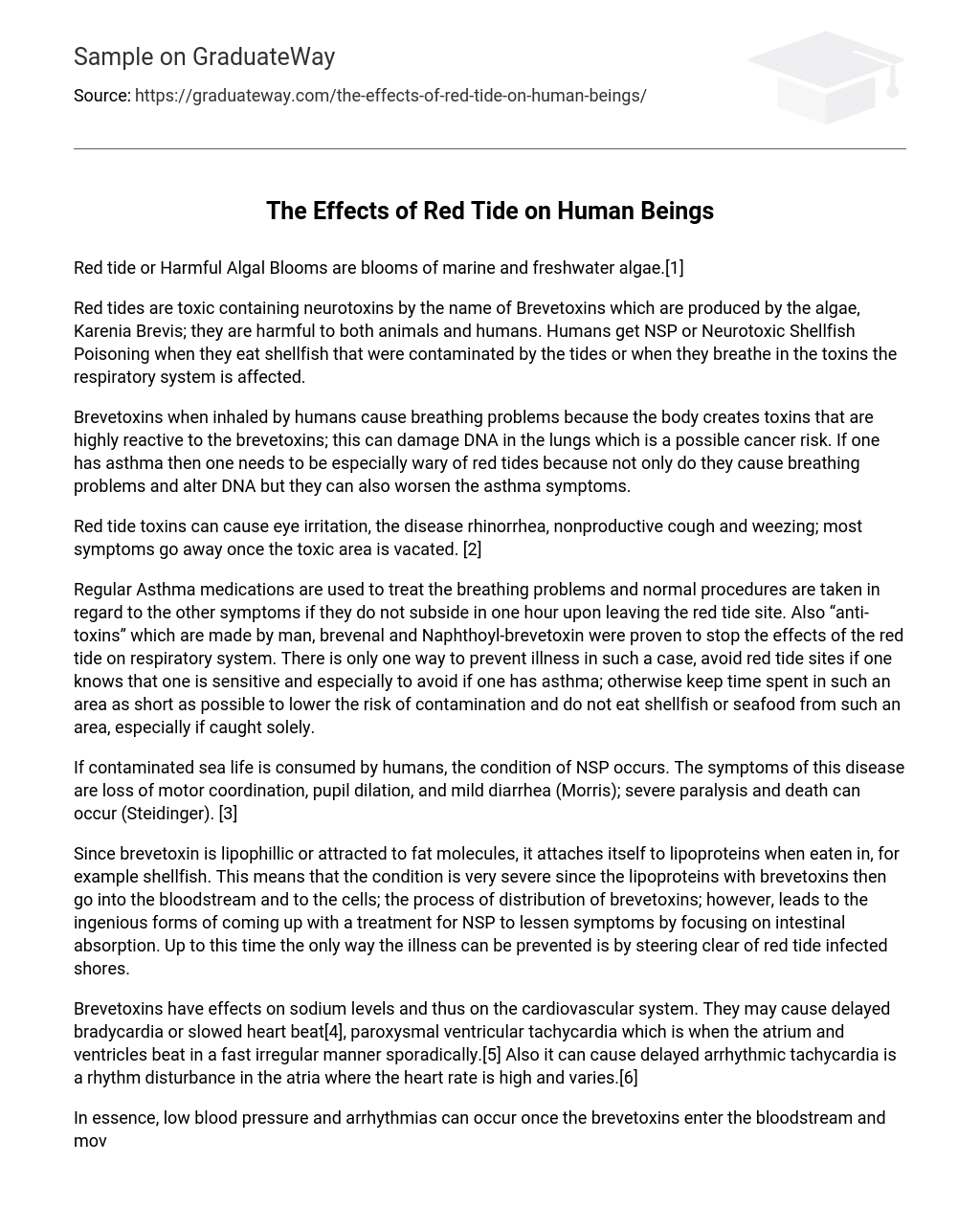Red tide or Harmful Algal Blooms are blooms of marine and freshwater algae.[1]
Red tides are toxic containing neurotoxins by the name of Brevetoxins which are produced by the algae, Karenia Brevis; they are harmful to both animals and humans. Humans get NSP or Neurotoxic Shellfish Poisoning when they eat shellfish that were contaminated by the tides or when they breathe in the toxins the respiratory system is affected.
Brevetoxins when inhaled by humans cause breathing problems because the body creates toxins that are highly reactive to the brevetoxins; this can damage DNA in the lungs which is a possible cancer risk. If one has asthma then one needs to be especially wary of red tides because not only do they cause breathing problems and alter DNA but they can also worsen the asthma symptoms.
Red tide toxins can cause eye irritation, the disease rhinorrhea, nonproductive cough and weezing; most symptoms go away once the toxic area is vacated. [2]
Regular Asthma medications are used to treat the breathing problems and normal procedures are taken in regard to the other symptoms if they do not subside in one hour upon leaving the red tide site. Also “anti-toxins” which are made by man, brevenal and Naphthoyl-brevetoxin were proven to stop the effects of the red tide on respiratory system. There is only one way to prevent illness in such a case, avoid red tide sites if one knows that one is sensitive and especially to avoid if one has asthma; otherwise keep time spent in such an area as short as possible to lower the risk of contamination and do not eat shellfish or seafood from such an area, especially if caught solely.
If contaminated sea life is consumed by humans, the condition of NSP occurs. The symptoms of this disease are loss of motor coordination, pupil dilation, and mild diarrhea (Morris); severe paralysis and death can occur (Steidinger). [3]
Since brevetoxin is lipophillic or attracted to fat molecules, it attaches itself to lipoproteins when eaten in, for example shellfish. This means that the condition is very severe since the lipoproteins with brevetoxins then go into the bloodstream and to the cells; the process of distribution of brevetoxins; however, leads to the ingenious forms of coming up with a treatment for NSP to lessen symptoms by focusing on intestinal absorption. Up to this time the only way the illness can be prevented is by steering clear of red tide infected shores.
Brevetoxins have effects on sodium levels and thus on the cardiovascular system. They may cause delayed bradycardia or slowed heart beat[4], paroxysmal ventricular tachycardia which is when the atrium and ventricles beat in a fast irregular manner sporadically.[5] Also it can cause delayed arrhythmic tachycardia is a rhythm disturbance in the atria where the heart rate is high and varies.[6]
In essence, low blood pressure and arrhythmias can occur once the brevetoxins enter the bloodstream and move about the body freely. Prevention methods are to not eat shellfish from red tide infected waters; however, if already ingested and if symptoms are clear, seeing a doctor is tremendously important for often it could mean the difference between life and death.
In the case of severe amounts of infected shellfish ingested, hospitalization is required as is often the case in any form of NSP or PSP (Paralytic Shellfish Poisoning).
Karenia Brevis is an algae that is harmless when it stands alone but when many with its brethren in what is noted in biology as bioconcentration also known colloquially as “red tide” then it can pose a threat to the ecosystem and more importantly can serve as a threat to human health.
Karenia Brevis is named for Karen Steidinger who is the leading biologist in the study of this algae and the one who “discovered” it; it is responsible for NSP, various cardiovascular, neurological, and digestive disorders and can be a stimulant for asthma. Effects of the red tide can be avoided if one does not go to the beach or carries an inhaler, does not go swimming in such an area unless sure that they will not be affected in the sense of burning eyes and skin irritation, and stays away from soft tissue shellfish and dead animals caught for consumption.
Bibiliography
- http://www.tulane.edu/~wiser/protozoology/notes/free.html
- http://video.about.com/heartdisease/Bradycardia.htm
- http://www.medicinenet.com/paroxysmal_supraventricular_tachycardia_psvt/article.htm
- http://www.emedicine.com/med/topic188.htm
- http://www.thefreelibrary.com/The+type+B+brevetoxin+(PbTx-3)+adversely+affects+development,+…-a0112983164
- http://www.chbr.noaa.gov/default.aspx?category=mb&pageName=tii3
- http://jrscience.wcp.muohio.edu/fieldcourses06/PapersMarineEcologyArticles/TheFloridaRedTide.html
- http://www.medicinenet.com/script/main/art.asp?articlekey=40721
- http://www.noaanews.noaa.gov/stories2008/20080709_redtide.html
- http://www.baysoundings.com/sum03/profile.html
- http://www.answers.com/topic/algal-bloom
- http://www.whoi.edu/science/B/redtide/illness/nsp.html
- http://www.floridamarine.org/features/view_article.asp?id=24936
- http://www.doh.state.fl.us/ENVIRONMENT/community/aquatic/pdfs/RedTideLitReview_2002112502.pdf
- http://www.start1.com/redtide/effects.aspx





